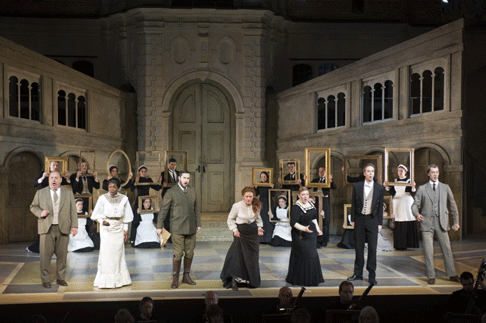Producer James
Clutton took to the stage to announce that the original Susanna, Claire
Meghnagi, had “left the production” and been replaced at short notice by
Jane Harrington. In addition, Matthew Hargreaves, our elegantly attired
factotum for the evening was not feeling on top form, but would soldier on
regardless.
To paraphrase Lady Bracknell, “to lose one principal may be regarded as a
misfortune; to lose two looks like carelessness”. In the event, if Hargreaves
was suffering it did not affect him too greatly; there were a few problems with
projection initially — he was rather tentative in the opening duets — but
he quickly warmed up and by ‘Se Vuol Ballare’ was well into his stride
(although conductor Matthew Willis nearly knocked him off-balance with some
unexpected and inexplicable changes of tempo). If Hargreaves fudged a few of
his notes at the top, it did not detract from a committed and lively
performance. His camp, mincing, Jeeves-like antics were energetic and
eye-catching, and he demonstrated a good sense of timing in what is an
intricately choreographed production.
As for Harrington, she slipped effortlessly into the comic capers and
complicated stage manoeuvres; she clearly knows this opera well, but if she
really had had only a few days of rehearsal, she must have a remarkable stage
memory. Her Susanna exuded brio, confidence and charm. Her Act 3 duet with the
Countess ‘Sull’ aria’ was exquisitely sweet and clear. Indeed, the vocal
expressivity of Elizabeth Llewellyn, as the disillusioned, disheartened
Countess, was one of the highlights of the evening. Both ‘Porgi amor’ and
‘Dove sono’ powerfully conveyed her distress and established her
aristocratic dignity. However, Llewellyn and her philandering Count, George von
Bergen, (equally strong vocally, his dark registers booming out to suggest
menace) are not the most convincing of actors and in a production that often
found them at the front of the stage, statically facing the audience, they
didn’t always make dramatic impact.
And, herein lies much of the problem with this production. For Liam Steel
frequently neglects to direct the principals while involving the chorus in
ceaseless hectic, and often distracting, activity. During the overture, the
hustle and bustle of the upstairs/downstairs world was captured by a seething
mass of servile retainers who rushed about the stage, plumping cushions, airing
linen, carrying silverware (a debt, conscious or otherwise, to David
McVicar’s ROH production?), and charging helter-skelter in and out of the
numerous doors which extended in sharp perspective from the arched walls of
Holland Park House (Emma Wee’s graceful set, cleverly calling the walls of
the house into action). Such frenetic commotion on stage was not matched in the
pit where, here and throughout the performance, rhythmic drive and forward
momentum — so essential to the comic impetus — were sadly lacking. In
general, Willis adopted an overly lyrical approach, eschewing the brisk
crispness of the Classical idiom; occasional exaggerated dynamic contrasts and
clumsy accelerations of pace could not inject the necessary joie de
vivre.
 Scene from The Marriage of Figaro [Photo by Fritz Curzon]
Scene from The Marriage of Figaro [Photo by Fritz Curzon]
There were some deft theatrical touches — Cherubino’s leap through the
chamber window into the geranium beds, for example, was neatly and wryly
effected — but on the whole there was too much clutter and fussy
choreography, which frequently hindered the singers’ attempts to establish
character and dramatic situation through the music itself. Thus, Lynton Black
struggled to convince us of Dr Bartolo’s vicious anger in the vengeful ‘La
vendetta’, as the chorus farcically waved red books to and fro in the
background; in case we were uncertain that Antonio (Henry Grant Kersell) is a
gardener, his arrival in search of the destroyer of his precious flowerbeds was
accompanied by a chorus of dancing geranium pots. When they weren’t parading
picture frames or pirouetting around the furniture, the chorus were placing
‘legless’ furniture beneath the derrieres of their distressed masters and
mistresses. The music was simply never allowed to speak for itself. Thus, even
Cherubino’s gauche outpouring of adolescent passion, ‘Voi che sapete’,
sung with bright clarity by a perky Hannah Pedley, was ‘illustrated’ by
some mimed shenanigans by the four principals, subsequently imitated in a
choreographed coda by a lower class quartet.
Although this chaotic stage business might have resembled a bedroom farce,
the fact is that it simply wasn’t funny. The unpoetic banalities of the
‘re-written libretto’ (I hesitate to use the word ‘translation’) did
not help; the surtitles not only lacked the grace of Da Ponte’s witty
couplets, but frequently had only a tenuous relationship to the events and
dialogue that the original libretto describes. Thus, despite some fine singing,
hyperactivity on stage contrasted with lethargy in the pit, and as darkness
fell, what is a long opera began to feel like a languorous one; one of the
finest musical comedies reduced to dramatic inertia.
Claire Seymour
image=http://www.operatoday.com/Mozart_libretto_figaro_1786.gif
image_description=Libretto of Le Nozze di Figaro, Prague 1786 [Image courtesy of Wikipedia]
product=yes
product_title=W. A. Mozart: The Marriage of Figaro
product_by=Figaro: Matthew Hargreaves; Susanna: Jane Harrington; Count Almaviva: George von Bergen; Countess Almaviva: Elizabeth Llewellyn; Cherubino: Hannah Pedley; Dr Bartolo: Lynton Black; Marcellina: Sarah Pring; Don Basilio/Don Curzio: Andrew Glover; Antonio: Henry Grant Kerswell; Barbarina: Jaimee Marshall. Conductor: Matthew Willis. Director: Liam Steel. Designer: Emma Wee. Lighting Designer: Colin Grenfell. Opera Holland Park, Saturday 2nd July 2011.
product_id=Above: Libretto of Le Nozze di Figaro, Prague 1786 [Image courtesy of Wikipedia]